Barnaul
Barnaul (Russian: Барнау́л, IPA: [bərnɐˈul]) is the largest city and administrative center of Altai Krai, Russia, located at the confluence of the Barnaulka and Ob Rivers in the West Siberian Plain. As of the 2010 Census, its population was 612,401,[9] making it the 21st largest city in Russia and the 4th largest in the Siberian Federal District.
Barnaul
Барнаул | |
|---|---|
City[1] | |
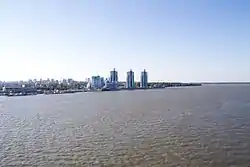 Barnaul from the Ob River bridge | |
 Flag  Coat of arms | |
| Anthem: None[2] | |
Location of Barnaul 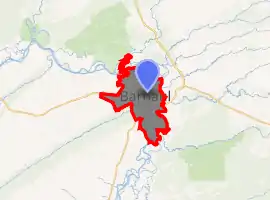
| |
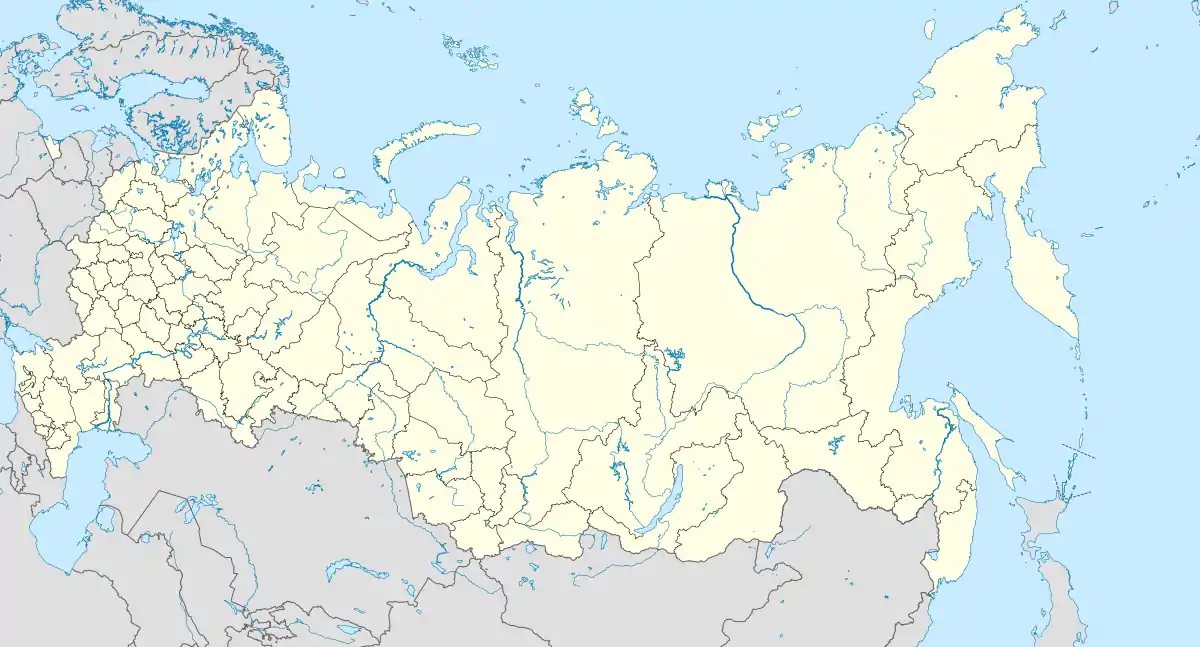 Barnaul Location of Barnaul 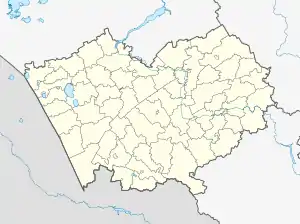 Barnaul Barnaul (Altai Krai) | |
| Coordinates: 53°20′N 83°45′E | |
| Country | Russia |
| Federal subject | Altai Krai[1] |
| Established | 1730[3] |
| City status since | 1771[4] |
| Government | |
| • Body | City Duma[5] |
| • Head[6] | Sergey Dugin[7] |
| Area | |
| • Total | 940 km2 (360 sq mi) |
| Elevation | 180 m (590 ft) |
| Population | |
| • Total | 612,401 |
| • Estimate (2018)[10] | 632,372 (+3.3%) |
| • Rank | 21st in 2010 |
| • Density | 650/km2 (1,700/sq mi) |
| • Subordinated to | City of krai significance of Barnaul[1] |
| • Capital of | Altai Krai[11], City of krai significance of Barnaul[1] |
| • Urban okrug | Barnaul Urban Okrug[12] |
| • Capital of | Barnaul Urban Okrug[12] |
| Time zone | UTC+7 (MSK+4 |
| Postal code(s)[14] | 656000, 656002–656004, 656006, 656008, 656010–656012, 656015, 656016, 656018, 656019, 656021, 656023–656025, 656031, 656033, 656035–656039, 656043–656045, 656048–656050, 656052–656060, 656062–656068, 656700, 656880, 656890, 656899, 656905, 656960, 656961, 656963–656966, 656998, 656999, 901024, 901213 |
| Dialing code(s) | +7 3852 |
| OKTMO ID | 01701000001 |
| City Day | One of the weekend days in August or September[3] |
| Website | [<span%20class="url"> |
| 2010 Census | 612,401[9] |
|---|---|
| 2002 Census | 600,749[15] |
| 1989 Census | 601,811[16] |
| 1979 Census | 533,263[17] |
Located in the south of western Siberia on the left bank of the Ob River, Barnaul is a major transport, industrial, cultural, medical and educational hub of Siberia. Barnaul was founded by the wealthy Demidov family, who intended to develop the production of copper and silver, which continued after the factories were taken over by the Crown. Barnaul became a major center of silver production in Russia. Barnaul was granted city status in 1771.
Administrative and municipal status
Barnaul is the administrative center of the krai.[11] Within the framework of administrative divisions, it is, together with the work settlement of Yuzhny and twenty-four rural localities, incorporated as the city of krai significance of Barnaul – an administrative unit with the status equal to that of the districts.[1] As a municipal division, the city of krai significance of Barnaul is incorporated as Barnaul Urban Okrug.[12]
Geography
Barnaul is located in the forest steppe zone of the West Siberian Plain, on the left bank of the Ob River, at the confluence of the Barnaulka and the Ob.
The border with Kazakhstan is 345 kilometers (210 mi) to the south, which makes Barnaul the closest major city to the Altai Mountains. The city is also situated relatively close to the Russian border with Mongolia and the border with China.
History
Ancient history
The area around the city has been inhabited by modern humans, Neanderthals and Denisovans, for hundreds of thousands of years. They settled here to take advantage of the confluence of the rivers, used for transportation and fishing. In the late BC millennia, the locality was a centre of activity for Scythian and various Turkic peoples.[18]
Russian Empire
While 1730 is considered Barnaul's official establishment date, its first mention dates back to 1724.[3] It was granted city status in 1771.[4] Chosen for its proximity to the mineral-rich Altai Mountains and its location on a major river, it was founded by the wealthy Demidov family.[4] The Demidovs wanted to develop the copper in the mountains, and soon found substantial deposits of silver as well. In 1747, the Demidovs' factories were taken over by the Crown. Barnaul became the center of silver production of the entire Russian Empire.[19]
In 1914, Barnaul was the site of the largest draft riot in Russia during World War I. There were more than 100 casualties from the fighting.[20]
Maria Stepanovna (née Zudilova) (1912–1996) was born and lived as a child in this city. She later became the mother of American actresses Natalie Wood (born Natalia Zakharenko) and Lana Wood (born Lana Gurdin).[21] Her father Stepan was killed in the 1918 street fighting between the Whites and Reds following the Revolution. Afterward her mother took Maria and her siblings as refugees to Harbin, China. Maria married a Russian there, and they had a daughter Olga together. Maria eventually immigrated with Olga to the United States, where she married another Russian immigrant, from Vladivostok, and had two daughters with him.[21]
World War II
Over half of the light ammunition used by the Soviet Union in World War II is estimated to have been manufactured in Barnaul.[22]
Economy
Barnaul is an important industrial center of Western Siberia. There are more than 100 industrial enterprises in the city, employing approximately 120,000 people. Leading industries include diesel and carbon processing; as well as production of heavy machinery, tyres, furniture and footwear.[23]
Transportation
Barnaul is located on the South Siberian, Turk–Sib and Omsk–Barnaul railway lines.[24] Barnaul has public transport of Bus, Trolley and Taxies.
Climate
The humid continental climate of Barnaul (Köppen Dfb) is defined by its geographical position at the southern end of the Siberian steppe: it is subject to long winters, with an average of −15.5 °C (4.1 °F) in January, but also enjoys a short warm season in the summer with an average temperature of 19.9 °C (67.8 °F) in July. Temperatures can vary in the extreme, from below −45 °C (−49 °F) in the winter to above 35 °C (95 °F) in the summer.
The climate is relatively dry. The average precipitation in the area is 433 millimeters (17.0 in) per year, 75% of which occurs during the region's warmer season. This means snow packs can be quite moderate in spite of the cold temperatures.
| Climate data for Barnaul | |||||||||||||
|---|---|---|---|---|---|---|---|---|---|---|---|---|---|
| Month | Jan | Feb | Mar | Apr | May | Jun | Jul | Aug | Sep | Oct | Nov | Dec | Year |
| Record high °C (°F) | 5.3 (41.5) |
7.4 (45.3) |
16.4 (61.5) |
32.3 (90.1) |
37.4 (99.3) |
36.6 (97.9) |
37.9 (100.2) |
38.3 (100.9) |
34.0 (93.2) |
27.4 (81.3) |
15.3 (59.5) |
6.3 (43.3) |
38.3 (100.9) |
| Average high °C (°F) | −10.8 (12.6) |
−8.1 (17.4) |
−0.6 (30.9) |
10.1 (50.2) |
20.1 (68.2) |
24.3 (75.7) |
26.3 (79.3) |
24.3 (75.7) |
17.7 (63.9) |
9.2 (48.6) |
−2.2 (28.0) |
−8.5 (16.7) |
8.5 (47.3) |
| Daily mean °C (°F) | −15.5 (4.1) |
−13.7 (7.3) |
−6.5 (20.3) |
3.8 (38.8) |
12.8 (55.0) |
17.7 (63.9) |
19.9 (67.8) |
17.4 (63.3) |
11.0 (51.8) |
3.8 (38.8) |
−6.3 (20.7) |
−12.9 (8.8) |
2.6 (36.7) |
| Average low °C (°F) | −20.1 (−4.2) |
−18.7 (−1.7) |
−11.8 (10.8) |
−1.2 (29.8) |
6.5 (43.7) |
11.6 (52.9) |
14.0 (57.2) |
11.6 (52.9) |
5.6 (42.1) |
−0.4 (31.3) |
−10.0 (14.0) |
−17.4 (0.7) |
−2.5 (27.5) |
| Record low °C (°F) | −48.2 (−54.8) |
−42.9 (−45.2) |
−35.5 (−31.9) |
−27.6 (−17.7) |
−8.8 (16.2) |
−1.2 (29.8) |
2.9 (37.2) |
0.4 (32.7) |
−7.8 (18.0) |
−27.0 (−16.6) |
−38.9 (−38.0) |
−43.1 (−45.6) |
−48.2 (−54.8) |
| Average precipitation mm (inches) | 24 (0.9) |
18 (0.7) |
17 (0.7) |
28 (1.1) |
40 (1.6) |
55 (2.2) |
68 (2.7) |
44 (1.7) |
43 (1.7) |
37 (1.5) |
37 (1.5) |
31 (1.2) |
433 (17.0) |
| Average rainy days | 0.4 | 1 | 3 | 12 | 17 | 16 | 17 | 15 | 16 | 14 | 6 | 1 | 118 |
| Average snowy days | 22 | 20 | 16 | 9 | 2 | 0.1 | 0 | 0 | 1 | 10 | 18 | 24 | 122 |
| Average relative humidity (%) | 78 | 76 | 74 | 63 | 55 | 64 | 70 | 70 | 69 | 73 | 79 | 79 | 71 |
| Mean monthly sunshine hours | 77 | 112 | 178 | 218 | 272 | 315 | 320 | 265 | 199 | 109 | 75 | 64 | 2,204 |
| Source 1: pogoda.ru.net[25] | |||||||||||||
| Source 2: NOAA (sun only, 1961-1990)[26] | |||||||||||||
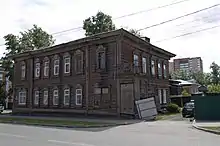
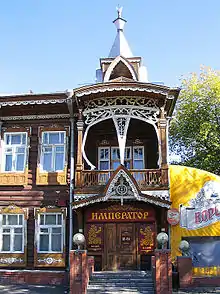
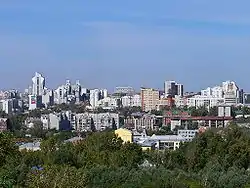
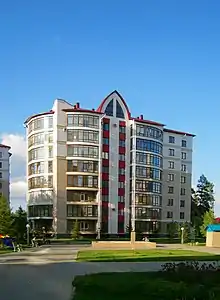
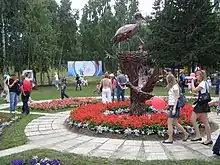

Notable people
- Andrei Svechnikov, hockey player; drafted 2nd overall in the 2018 draft by the Carolina Hurricanes
- Evgeny Svechnikov, Detroit Red Wings prospect in the NHL
- Maria Butina, political activist and alleged Russian agent
- Pyotr Kozmitch Frolov, scientist and inventor
- Tatyana Kotova, Olympic champion in long jump
- Julia Neigel, singer, songwriter
- Ivan Nifontov, World champion and Olympic medalist in Judo
- Alexey Novikov-Priboy, writer
- Ivan Polzunov, inventor, creator of the first two-cylinder engine in the world
- Konstantin Scherbakov, pianist
- Sergey Shubenkov, track and field athlete, 2015 world champion[27]
- Nadezhda Shuvayeva-Olkhova, Olympic champion in basketball
- Alexey Smertin, former captain of the Russia national football team
- Rita Streich, coloratura soprano
- Nikolai Yadrintsev, explorer and archeologist, discoveries include the Orkhon script, Genghis Khan's capital, Karakorum
- Mikhail Yakubov, NHL and KNL professional hockey player
- Mikhail Yevdokimov, comedian and former governor of Altai Krai
Twin towns – sister cities
See also
- Nagorny Park
- Tsentralny City District, Barnaul
 Siberia portal
Siberia portal
References
Footnotes
- Law #28-ZS
- According to Article 5 of the Charter of Barnaul, the official symbols of the city Archived February 24, 2017, at the Wayback Machine include only a flag and a coat of arms.
- Charter of Barnaul, Article 4
- Энциклопедия Города России. Moscow: Большая Российская Энциклопедия. 2003. pp. 36–38. ISBN 5-7107-7399-9.
- Charter of Barnaul, Article 37
- Charter of Barnaul, Article 46
- Official website of Barnaul. City Administration Archived June 22, 2017, at the Wayback Machine (in Russian)
- Official website of Barnaul. Geography Archived June 2, 2017, at the Wayback Machine (in Russian)
- Russian Federal State Statistics Service (2011). "Всероссийская перепись населения 2010 года. Том 1" [2010 All-Russian Population Census, vol. 1]. Всероссийская перепись населения 2010 года [2010 All-Russia Population Census] (in Russian). Federal State Statistics Service.
- http://www.gks.ru/free_doc/doc_2018/bul_dr/mun_obr2018.rar; archive date: 26 July 2018; retrieved: 25 July 2018; archive URL: https://web.archive.org/web/20180726010024/http://www.gks.ru/free_doc/doc_2018/bul_dr/mun_obr2018.rar.
- Charter of Altai Krai, Article 6
- Law #144-ZS
- "Об исчислении времени". Официальный интернет-портал правовой информации (in Russian). June 3, 2011. Retrieved January 19, 2019.
- Почта России. Информационно-вычислительный центр ОАСУ РПО. (Russian Post). Поиск объектов почтовой связи (Postal Objects Search) (in Russian)
- Russian Federal State Statistics Service (May 21, 2004). "Численность населения России, субъектов Российской Федерации в составе федеральных округов, районов, городских поселений, сельских населённых пунктов – районных центров и сельских населённых пунктов с населением 3 тысячи и более человек" [Population of Russia, Its Federal Districts, Federal Subjects, Districts, Urban Localities, Rural Localities—Administrative Centers, and Rural Localities with Population of Over 3,000] (XLS). Всероссийская перепись населения 2002 года [All-Russia Population Census of 2002] (in Russian).
- "Всесоюзная перепись населения 1989 г. Численность наличного населения союзных и автономных республик, автономных областей и округов, краёв, областей, районов, городских поселений и сёл-райцентров" [All Union Population Census of 1989: Present Population of Union and Autonomous Republics, Autonomous Oblasts and Okrugs, Krais, Oblasts, Districts, Urban Settlements, and Villages Serving as District Administrative Centers]. Всесоюзная перепись населения 1989 года [All-Union Population Census of 1989] (in Russian). Институт демографии Национального исследовательского университета: Высшая школа экономики [Institute of Demography at the National Research University: Higher School of Economics]. 1989 – via Demoscope Weekly.
- "Всесоюзная перепись населения 1979 г. Национальный состав населения по регионам России" [All Union Population Census of 1979. Ethnic composition of the population by regions of Russia] (XLS). Всесоюзная перепись населения 1979 года [All-Union Population Census of 1979] (in Russian). 1979 – via Demoscope Weekly (website of the Institute of Demographics of the State University—Higher School of Economics.
- Minns, Ellis Hovell (January 13, 2011). Scythians and Greeks: A Survey of Ancient History and Archaeology on the North Coast of the Euxine from the Danube to the Caucasus. Cambridge University Press. ISBN 9781108024877. Retrieved January 1, 2018 – via Google Books.
- "Пятые Бородавкинские чтения". new.hist.asu.ru. Archived from the original on July 25, 2012. Retrieved January 1, 2018.
- Sanborn, Josh. "The Mobilization of 1917 and the Question of the Russian Nation." Slavic Review, Vol. 59, No. 2: pp. 267-89.
- Lambert, Gavin (2004). Natalie Wood: A Life, London: Faber and Faber, p.8. ISBN 978-0-571-22197-4
- "Archived copy". Archived from the original on October 27, 2012. Retrieved 2015-03-28.CS1 maint: archived copy as title (link)
- "Barnaul". Encyclopaedia Britannica. Retrieved November 8, 2019.
- "Weather And Climate - Climate Barnaul" (in Russian). Retrieved May 14, 2015.
- "Climate Normals for Barnaul". National Oceanic and Atmospheric Administration. Retrieved January 23, 2013.
- "Сергей Шубенков выиграл "золото" на Чемпионате мира по лёгкой атлетике в Пекине". Retrieved January 1, 2018.
- "США, Испания и Китай: в каких еще странах у Барнаула есть города-побратимы?". tolknews.ru (in Russian). Tolk. October 31, 2020. Retrieved November 30, 2020.
- "Град Шумен – Как да ни намерите". tourism-shumen.com (in Bulgarian). Tourism Shumen. Retrieved July 14, 2020.
Sources
- Барнаульская городская Дума. Решение №789 от 20 июня 2008 г. «Устав городского округа — города Барнаула Алтайского края», в ред. Решения №766 от 31 марта 2017 г. «О внесении изменений в Устав городского округа — города Барнаула Алтайского края (в ред. Решения от 16.12.2016 №706)». Вступил в силу со дня официального опубликования (15 июля 2008 г.) (за исключением отдельных положений, вступивших в силу в иные сроки). Опубликован: "Вечерний Барнаул", №103, 15 июля 2008 г. (Barnaul City Duma. Decision #789 of June 20, 2008 Charter of the Urban Okrug—the City of Barnaul of Altai Krai, as amended by the Decision #766 of March 31, 2017 On Amending the Charter of the Urban Okrug—the City of Barnaul of Altai Krai (rev. #706 of December 16, 2016). Effective as of the day of the official publication (July 15, 2008) (with the exception of clauses which take effect on different dates).).
- Алтайское краевое Законодательное Собрание. №3-ЗС 5 июня 1995 г. «Устав (основной закон) Алтайского края», в ред. Закона №118-ЗС от 1 декабря 2015 г. «О внесении изменений в Устав (Основной Закон) Алтайского края». Опубликован: "Алтайская правда", №100, 14 июня 1995 г. (Altai Krai Legislative Assembly. #3-ZS June 5, 1995 Charter (Basic Law) of Altai Krai, as amended by the Law #118-ZS of December 1, 2015 On Amending the Charter (Basic Law) of Altai Krai. ).
- Алтайский краевой Совет народных депутатов. Закон №28-ЗС от 1 марта 2008 г. «Об административно-территориальном устройстве Алтайского края», в ред. Закона №16-ЗС от 4 апреля 2017 г. «О присоединении станции Железнодорожная Казарма 572 км к посёлку Октябрьскому Октябрьского сельсовета Кулундинского района Алтайского края и внесении изменений в отдельные законы Алтайского края». Вступил в силу 8 марта 2008 г. Опубликован: "Алтайская правда", №67, 8 марта 2008 г. (Altai Krai Council of People's Deputies. Law #28-ZS of March 1, 2008 On the Administrative-Territorial Structure of Altai Krai, as amended by the Law #16-ZS of April 4, 2017 On Merging the Station of Zheleznodorozhnaya Kazarma 572 km into the Settlement of Oktyabrsky in Oktyabrsky Selsoviet of Kulundinsky District of Altai Krai and on Amending Various Laws of Altai Krai. Effective as of March 8, 2008.).
- Алтайское краевое Законодательное Собрание. Закон №144-ЗС от 27 декабря 2008 г. «О статусе и границах муниципального и административно-территориального образования город Барнаул Алтайского края», в ред. Закона №44-ЗС от 2 июля 2009 г «О внесении изменений в Приложение 1 к Закону Алтайского края "О статусе и границах муниципального и административно-территориального образования город Барнаул Алтайского края"». Вступил в силу через 10 дней после дня официального опубликования. Опубликован: "Алтайская правда", №5–6, 15 января 2009 г. (Altai Krai Legislative Assembly. Law #144-ZS of December 27, 2008 On the Status and the Borders of the Municipal and the Administrative-Territorial Formation of the City of Barnaul of Altai Krai, as amended by the Law #44-ZS of July 2, 2009 On Amending Appendix 1 of the Law of Altai Krai "On the Status and the Borders of the Municipal and the Administrative-Territorial Formation of the City of Barnaul of Altai Krai". Effective as of the day which is 10 days after the day of the official publication.).
External links
 Barnaul travel guide from Wikivoyage
Barnaul travel guide from Wikivoyage- . Encyclopædia Britannica. 3 (11th ed.). 1911.
- Official website (in Russian)